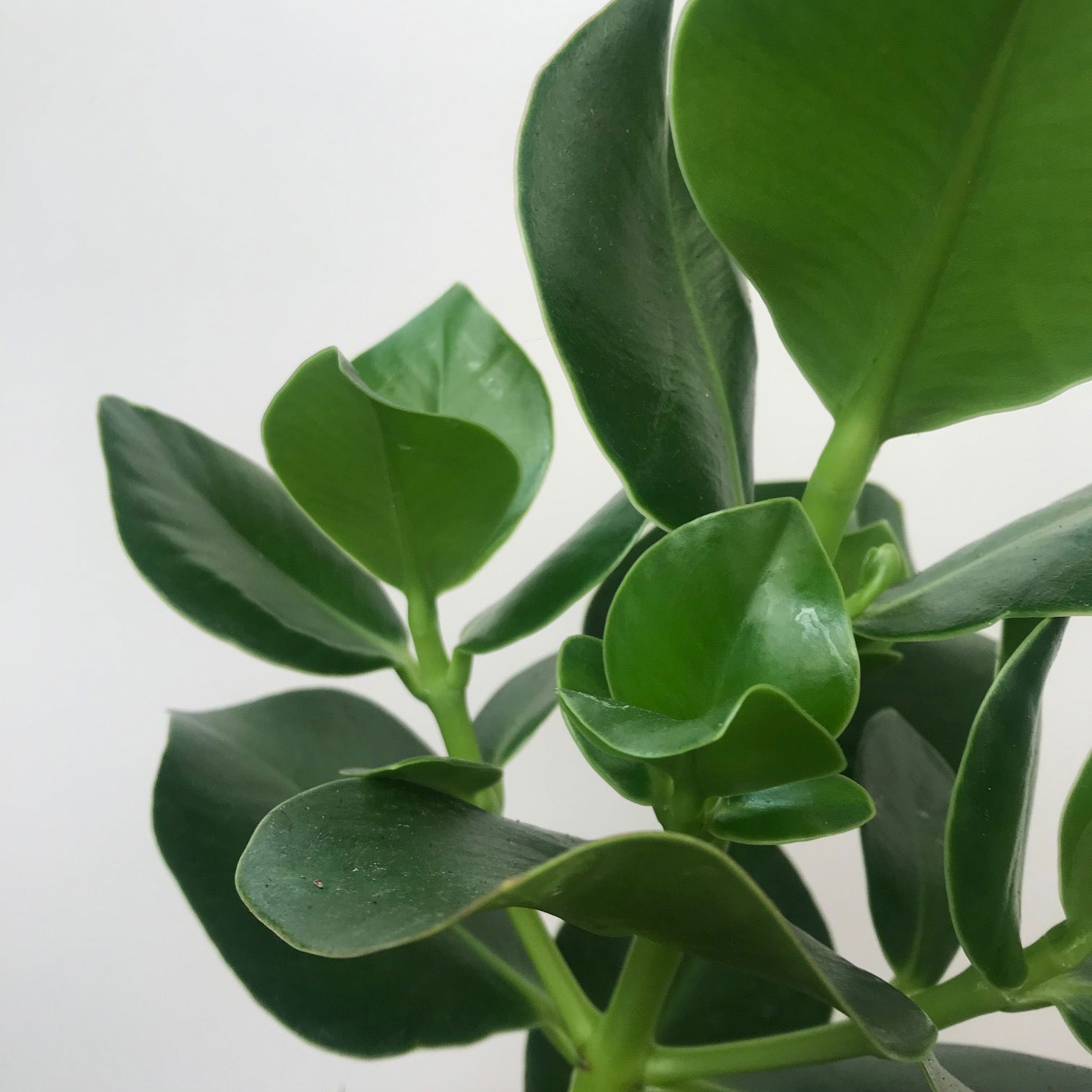
Clusia rosea
Contents
- Top Tips
- Location, Water, Humidity & Fertilisation
- Growing Autograph Trees in Water (Hydroponics)
- Common Issues
- Origins, Temperature, Propagation, Repotting & Toxicity.
Need the answer to a specific plant query? Book a 1-to-1 video call with THE HOUSEPLANT DOCTOR™, the website's friendly author, to overcome and address your niggling problem! Available on iMessage, WhatsApp, Facebook Messenger & more.
Top Tips & Info
If your specimen is grown in water hydroponically, scroll down to 'Growing Autograph Trees in Water' for more tailored information.
- Care Difficulty - Easy to Moderate
- Provide a bright, indirect location with little to no direct sunlight. If it's bright enough to read a newspaper without the use of artificial light, it'll be enough for the plant, too!
- Autograph Trees require moist soil, with the top few inches drying out in between waters. Always avoid over-watering, as the risk of root rot and stem collapse is rather high, especially during the winter period.
- Fertilise using a 'Houseplant' labelled feed every four waters in the spring and summer, reducing this to every six in the colder months.
- Repot every two years during the spring, using a 'Houseplant' labelled potting mix.
- Keep an eye out for Spider Mites, Mealybugs & Scale that'll hide in the plant's cubbyholes.
Location & Light - 🔸🔸
Perfecting the amount of light an Autograph Tree receives is crucial for a long-lasting specimen. During the spring and summer, be sure to provide a brightly lit spot away from any direct light. Excessive exposure during this time will negatively affect the plant in the likes of sun-scorch and dehydration. Once the autumn kicks in, be sure to include an hour or two of direct light per day to get it through the dormancy period, lasting until the following spring.
Water - 🔸🔸
Autograph Plants are best kept in reliably moist soil, as inconsistent moisture levels may result in stunted growth and an unhappy plant. Allow the compost's top third to dry out in between waters in the growing period, reducing this further in the autumn and winter. Due to the sensitivity of their root systems, never apply cold water as it may weaken its health and overall well-being. For those that use tap water (instead of rainwater or fresh bottled water), allow it to stand for at least 24hrs to eliminate the high levels of chloride and fluoride found from the tap. Under-watering symptoms include a shrivelled stem, yellowing leaves, little to no growth and dry, crispy patches forming on the leaf edges. These issues are usually caused by too much light/heat or forgetfulness. Remember, the brighter the location, the more watering you'll need to do. Over-watering symptoms include a weakened or rotten stem, no new growth, yellowing lower leaves and eventual plant death. Click here to learn more about root rot and how to address it!
Humidity - 🔸
Average room humidity is more than enough to satisfy this plant. Never situate it within a few metres of an operating radiator due to the enriched chance of browning leaf-tips.
Fertilisation - 🔸🔸
Fertilise every four waters during the growing period before reducing this to every six in the autumn & winter. Although an 'All-Purpose' fertiliser will still do the job, we'd recommend using a specific 'Houseplant' labelled fertiliser as it'll support the vital thirteen nutrients that this species will need to grow.
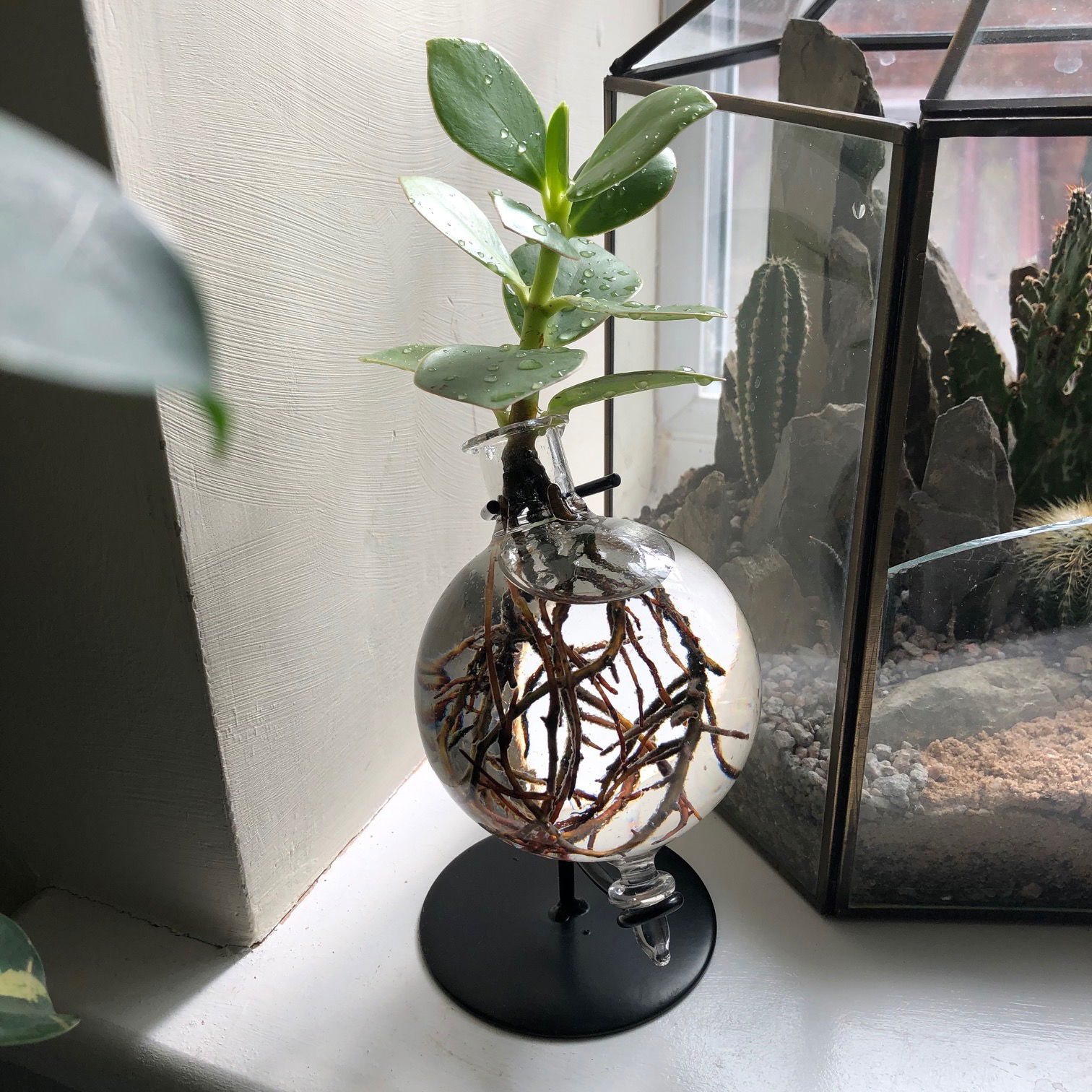 The following section is tailored for specimens grown in water (hydroponically).
The following section is tailored for specimens grown in water (hydroponically).
Growing Autograph Trees in Water (Hydroponics)
Read the following information if yours is grown hydroponically in water. THE HOUSEPLANT DOCTOR™ wouldn't recommend converting a soil-rooted Autograph Tree into water due to the risk of plant death (via 'Transplant Shock') being very high. Take stem cuttings if you desire a water-borne specimen.
Growing any houseplant in water will need to be placed in soil at some stage to continue its life. The combination of poor air circulation around the roots and lack of nutrients will eventually weaken the specimen, thus increasing the chance of death. In our opinion, the maximum lifespan for an Autograph Plant in water is around two to three years before it requires being transplanted into a 'Houseplant' labelled potting mix and a 10cm pot.
Location - Its location within the home is a crucial element to consider when growing this plant in water. Remember that those raised in darker areas are much more likely to adopt root rot than others in brighter areas. By no means should they be exposed to direct sunlight, but a place that offers bright, indirect light is best for healthy growth. A north-facing windowsill, or within a metre of a window is somewhere to consider.
Water & Hygiene - Hydroponic specimens are much easier to care for than their soil-borne counterparts as long as you maintain good hygiene. It's essential to keep the water clean by replacing it weekly with tap water that has sat in a non-metal container for around 24hrs. This will not only reduce the heightened levels of chloramine and fluoride, but it'll also downplay the risk of exposing this plant to cold root temperatures.
The plant should stay in the original water until the new water has served its 24hr period. Whilst the plant is momentarily out of the water, rinse the root system with the tap to remove any issues of rot before replacing it back into the original glass container with the new water. If there's a development of algae on the roots or glass, or that the root caps are beginning to rot, this is a clear indication of poor water hygiene that must be addressed immediately. Wipe the glass with water and your fingers, avoiding the use of soap or other chemicals, and rinse the roots under the tap for twenty seconds. Then, replace the water with fresh tap-water (that has stood for 24hrs) and place the specimen in new water to reduce the risk of re-emergence.
Fertilisation - We'd recommend a concentrated product to avert the risk of over-supplementation. Once a month, during a water-change (as mentioned above), add a few fertiliser drops into the new water before allowing it to sit for 24hrs. Mix the solution in well and place the plant back into the water once this resting period is over to administer the feed!
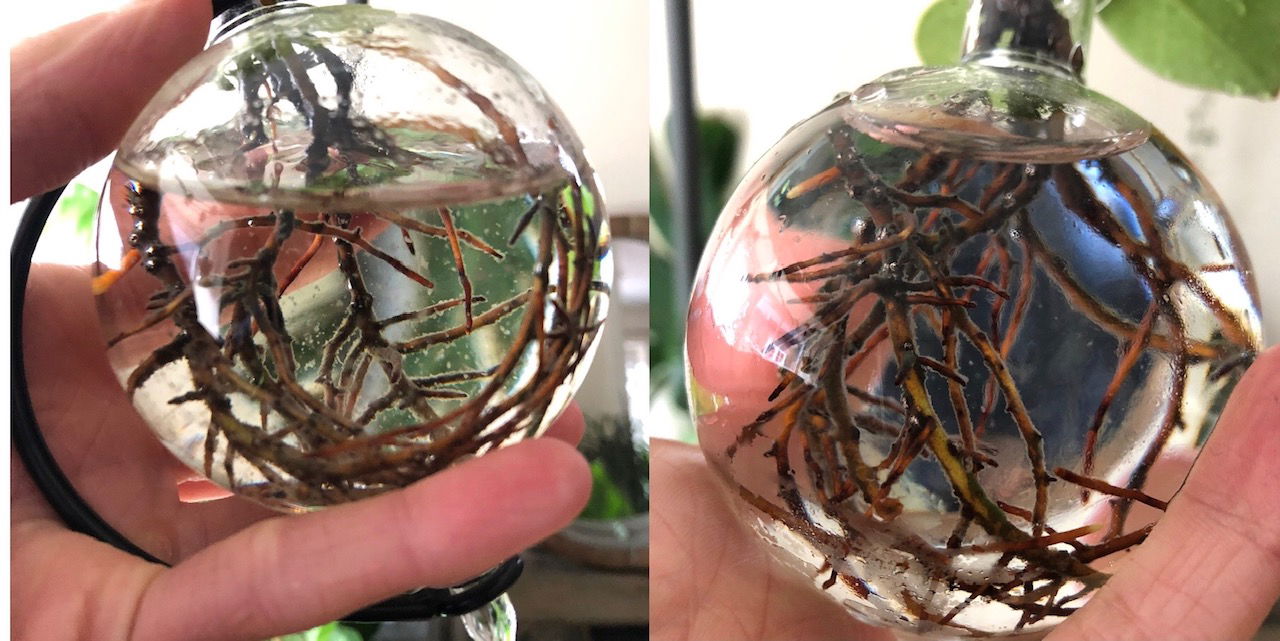 Although small colonies of algae aren't too much of an issue in terms of the plant's health, it's essential to keep the water hygiene as optimum as possible to maintain good quality growth. The image above is the before & after shots of once the roots and glass are rinsed and cleaned with water.
Although small colonies of algae aren't too much of an issue in terms of the plant's health, it's essential to keep the water hygiene as optimum as possible to maintain good quality growth. The image above is the before & after shots of once the roots and glass are rinsed and cleaned with water.
 Healthy root caps are a good indication of the plant's overall health.
Healthy root caps are a good indication of the plant's overall health.
Common Issues with Autograph Trees (Clusia rosea)
If your specimen is located in a dark environment with mould developing on the compost's top layer, use a chopstick to stab the soil in various areas gently. You should aim to enter the compost between the base of the plant and the pot's edge, as failure to do so may lead to damaging its lower portion. Leave the holes open for a few days before re-surfacing the soil to avoid it becoming overly dry. Not only will the gentle shift in the soil's structure mimic the work of small invertebrates in the wild (worms, etc.), but it'll also add oxygen back into the soil, thus reducing the risk of root rot. Repeat this monthly, or whenever you feel the potting-mix isn't drying out quickly enough.
As mentioned above, Autograph Trees will only have a certain lifespan in water, so transplanting them into soil is a crucial part of keeping yours alive for years to come. Because of poor air circulation and nutrient deficiencies found in beds of water, prolonged periods of more than two years will eventually see your specimen develop root rot, weak health and yellowed leaves. If this has occurred with yours, be sure to prune away the affected roots and leaves, before transplanting it into an 8cm pot with 'Houseplant' labelled compost to see if this helps revitalise its root systems.
 If your Clusia rosea (Autograph Plant) develops raised brown spots/bumps on its foliage, this could be an issue with its soil and root system. THE HOUSEPLANT DOCTOR™ recommends taking the plant out of its pot to inspect the root system. A healthy root system should be cream coloured and hard when pinched; whereas an unhealthy system will be brown, softened and can be easily pulled off the plant. If the roots look happy, he recommends feeding more often with a salt-based fertiliser every third water, along with increasing the light levels to a north, east or west-facing windowsill. Only use lukewarm water and hydrate once the soil's top few inches dries out, too. Click here to learn more about treating root rot!.
If your Clusia rosea (Autograph Plant) develops raised brown spots/bumps on its foliage, this could be an issue with its soil and root system. THE HOUSEPLANT DOCTOR™ recommends taking the plant out of its pot to inspect the root system. A healthy root system should be cream coloured and hard when pinched; whereas an unhealthy system will be brown, softened and can be easily pulled off the plant. If the roots look happy, he recommends feeding more often with a salt-based fertiliser every third water, along with increasing the light levels to a north, east or west-facing windowsill. Only use lukewarm water and hydrate once the soil's top few inches dries out, too. Click here to learn more about treating root rot!.
Dull, yellowed leaves could be the sign of a nutrient deficiency - most common with water-grown specimens. To rebalance the nutrient value within your plant, ensure to transplant it into a 'Houseplant' labelled compost with an 8cm plastic pot. The nutrients stored in the compost will work for around two months before the specimen will need regular feeds once every four to six waters. The new growth should look fresh and ready for action, with the older leaves eventually dying off through maturity.
Yellowing lower leaves could be a sign of over-watering, but equally is a byproduct of maturity. If the older leaves rapidly become yellow in quick succession, over-watering could be to blame. People don't realise that a plant's root system needs access to oxygen too; when soil is watered, the air will travel upwards and out of the potting mix. A lack of accessible oxygen for the roots will cause them to subsequently breakdown over the oncoming days. Click on this link to learn more about root rot and how to address it.
 Red aerial roots may develop from the stems, measuring up to 75cm (20 inches) in some cases. Although you can remove the root, THE HOUSEPLANT DOCTOR™ recommends to simply point/angle it into the soil to create its own root system.
Red aerial roots may develop from the stems, measuring up to 75cm (20 inches) in some cases. Although you can remove the root, THE HOUSEPLANT DOCTOR™ recommends to simply point/angle it into the soil to create its own root system.
Never allow temperatures to dip below 10ºC (50ºF) as irreversible damage may occur in the likes of blackened foliage and weak growth. If this happens, remove the severely affected areas and immediately improve growing conditions - never cut through softened yellow growth. As rehabilitation can take several months because of its slow-growing nature, be sure to provide a stable location with better growing conditions to speed this process.
Transplant shock is a big issue when it comes to heavy-handed repots. Give the plant a good soak 24hrs before the action and never tinker with the roots, unless it has been affected by root rot. Typical signs of transplant shock are largely similar to under watering, with wilting, yellowing leaves and stunted growth among the most common symptoms. Click here to learn more about addressing transplant shock and a step-by-step guide on performing the perfect transplant.
There are several reasons why your hydroponically-grown specimens are showing signs of root rot and a general decline of health. Firstly, the environment that they're in could be to blame. Is there enough light to read a newspaper? If not, improve the growing conditions by increasing indirect light, avoiding the threat of excessive direct sunlight. The plant's size will play a big part in its success; smaller specimens (5cm in length or less) won't root appropriately due to the lower amounts of stored energy. Further, the water must also be replaced weekly to ensure nasty bacteria cannot breed and decay on the plant. If the bottom of the stem is brown and mushy, discard immediately as the rot will spread onto unaffected areas. Autograph Trees are always best grown in soil, as its roots will need a balance of oxygen and water. Remember - the further into the water you go, the less accessible oxygen there is for the plant to utilise, thus resulting in root rot. Check the root tips and along the base of the plants for any signs of this. Transplant your Autograph Tree into 'Houseplant' labelled compost (available at garden centres) and an 8cm pot to provide a more oxygen-rich environment to limit the spread of root rot.
Finally, failed propagated stem cuttings (from a mature plant) - There are several reasons why the cuttings haven't rooted well, including: the time of year (spring or summer is best), its size (Autograph Trees stem cuttings should be at least 7cm (3 inches) in length), poor growing conditions (replace water weekly for water-propagated cuttings, and avoid over-watering for soil-grown plants), and its growing environment (a bright sunless windowsill and warmth is important).
Origins
Nicolaus von Jacquin first described Clusia rosea back in 1760, honouring 17th-century French botanist, Charles de Lécluse (Carolus Clusius). The specific epithet, rosea, refers to the pink fruits that develop shortly after flower pollination. The species has natural distributions across the Central Americas, ranging from south Mexico to north Columbia.
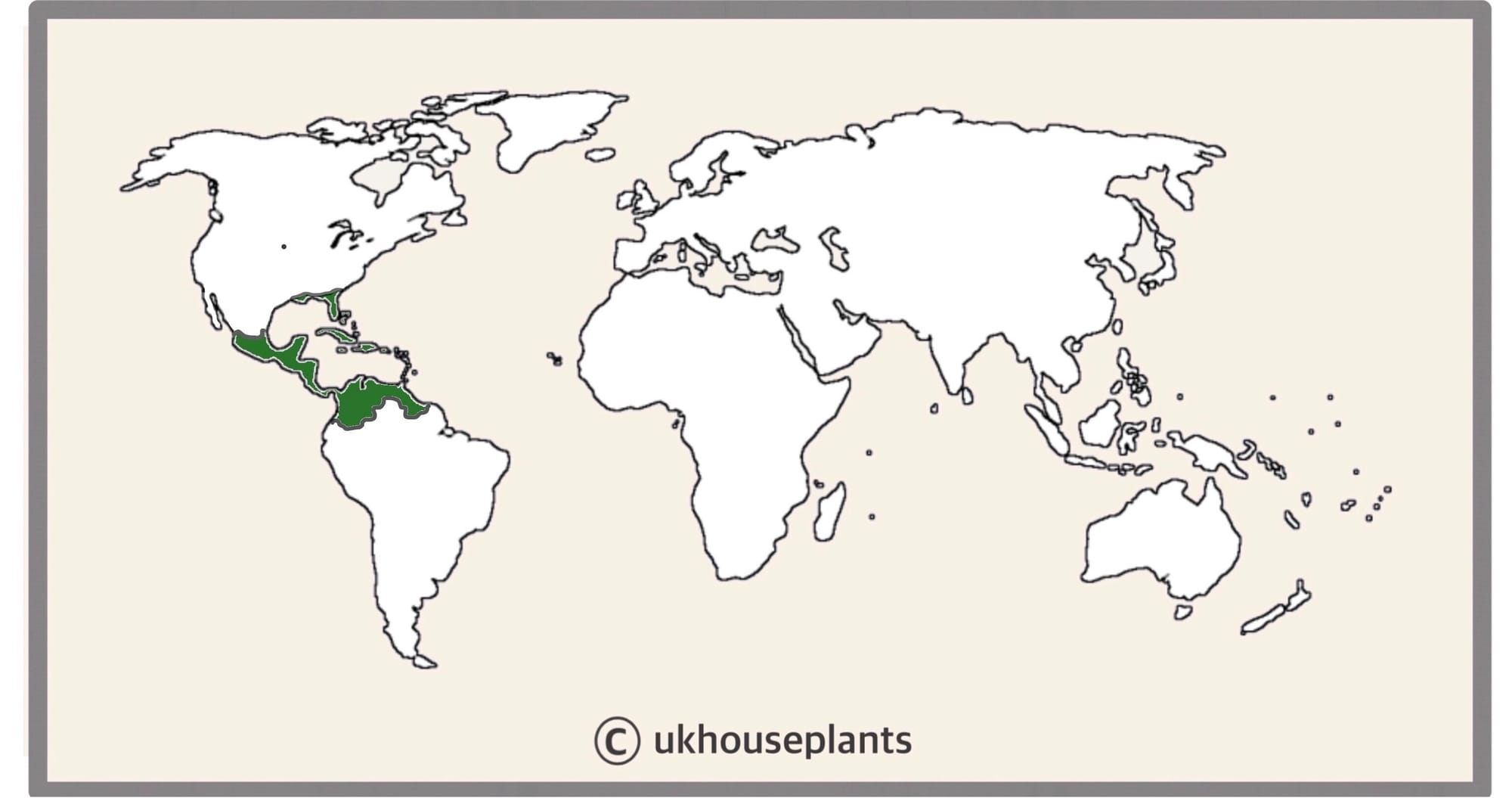 The Distribution of Clusia rosea.
The Distribution of Clusia rosea.
Temperature
12° - 32℃ (54° - 90℉)
H1b (Hardiness Zone 12) - Can be grown outdoors during the spring and summer in a sheltered location whilst nighttime temperatures are above 12℃ (54℉), but is fine to remain indoors, too. If you decide to bring this plant outdoors, don't allow it to endure more than an hour of direct sunlight a day as it may result in sun-scorch. Regularly keep an eye out for pests, especially when re-introducing it back indoors.
Spread
The overall size can be up to 1.6m (5ft) in height and 0.6m (2ft) in width. The ultimate size will take between 8 - 10 years to achieve when repotted biannually, with several new leaves unfurling per annum.
Pruning & Maintenance
Remove yellow or dying leaves, and plant debris to encourage better-growing conditions. While pruning, always use clean scissors or shears to reduce the chance of bacterial and fungal diseases. Never cut through yellowed tissue as this may cause further damage in the likes of diseases or bacterial infections. Remember to make clean incisions as too-damaged wounds may shock the plant, causing weakened growth and a decline in health.
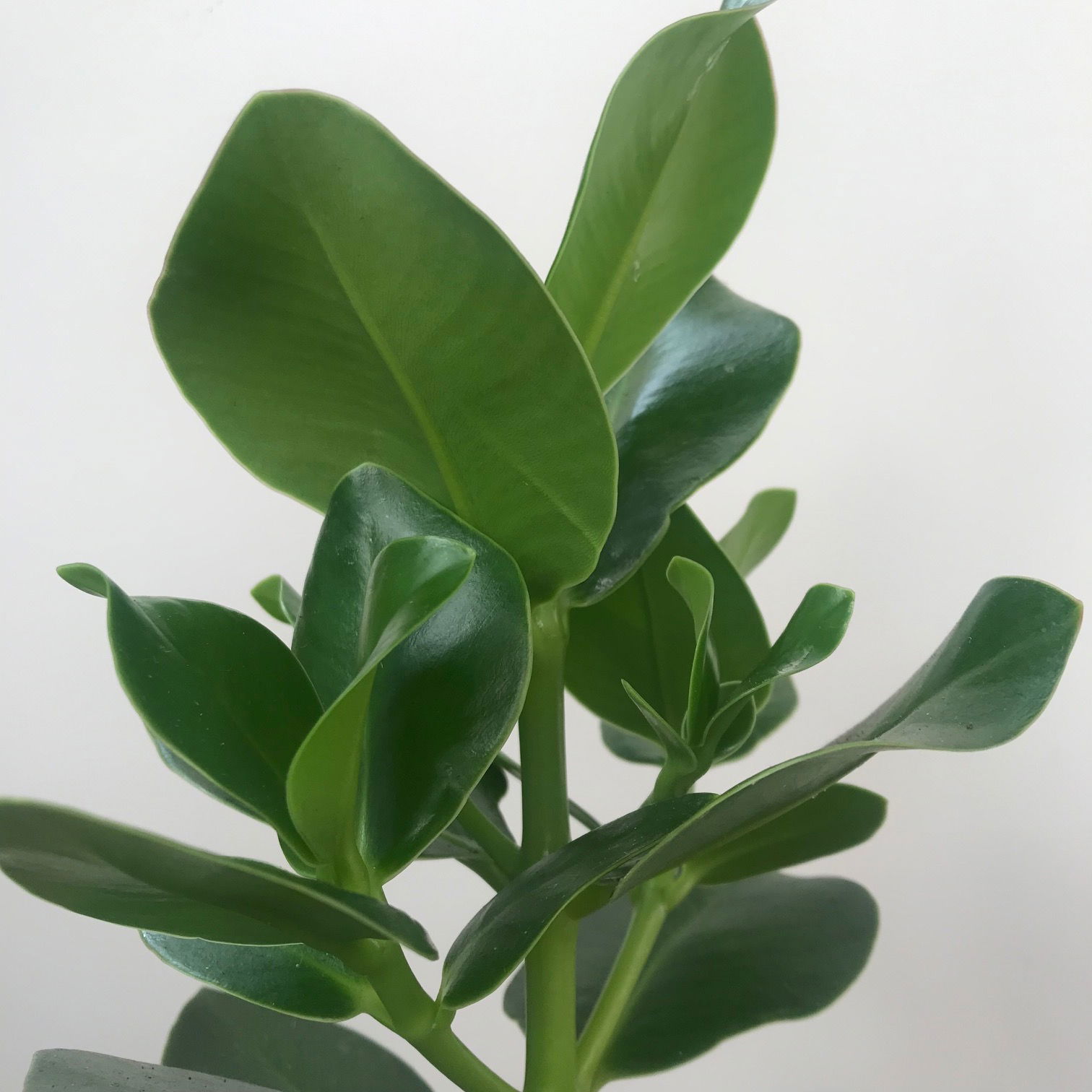 Autograph Plants are hemiepiphytic, meaning that they'll grow initially as an epiphyte on trees or rocks, much similar to a strangling fig (Ficus).
Autograph Plants are hemiepiphytic, meaning that they'll grow initially as an epiphyte on trees or rocks, much similar to a strangling fig (Ficus).
Propagation
Via Seed or Stem Cuttings.
Stem Cuttings (Easy to Moderate) - This method is an easy way to duplicate the original plant. Stems that are at least 8cm (3 inches) in height and part of an established plant are most successful. To avoid making a mess of the serrations, use a clean pair of scissors and cut 8cm down from the stem's end, dipping the wound in water and then into rooting hormone to speed the propagation. Rooting can take in the range of between two to eight weeks, depending on environmental factors and the cutting's quality. THE HOUSEPLANT DOCTOR™ recommends using a 'Houseplant' labelled potting mix, with a pot that has adequate drainage to avert the risk of basal rot. Provide a bright, warm setting of around 18℃ (64℉) with relatively moist soil, but be sure to allow the top half to dry out in between waters. You'll know if propagation is successful as the leaves will stay green and firm, along with small roots developing from the callous (dried wound). New foliar growth will emerge from the nodes after around twelve weeks, but it may take longer if the conditions aren't optimal. After a month of solid new foliar growth, transplant into a slightly bigger pot and treat it like a mature specimen with the care tips provided above.
Flowers
Autograph Trees will rarely flower in their lifetimes when domestically grown; however, for the interest of this section, their inflorescence is mostly white with thin, broad petals that are put out in the early summer.
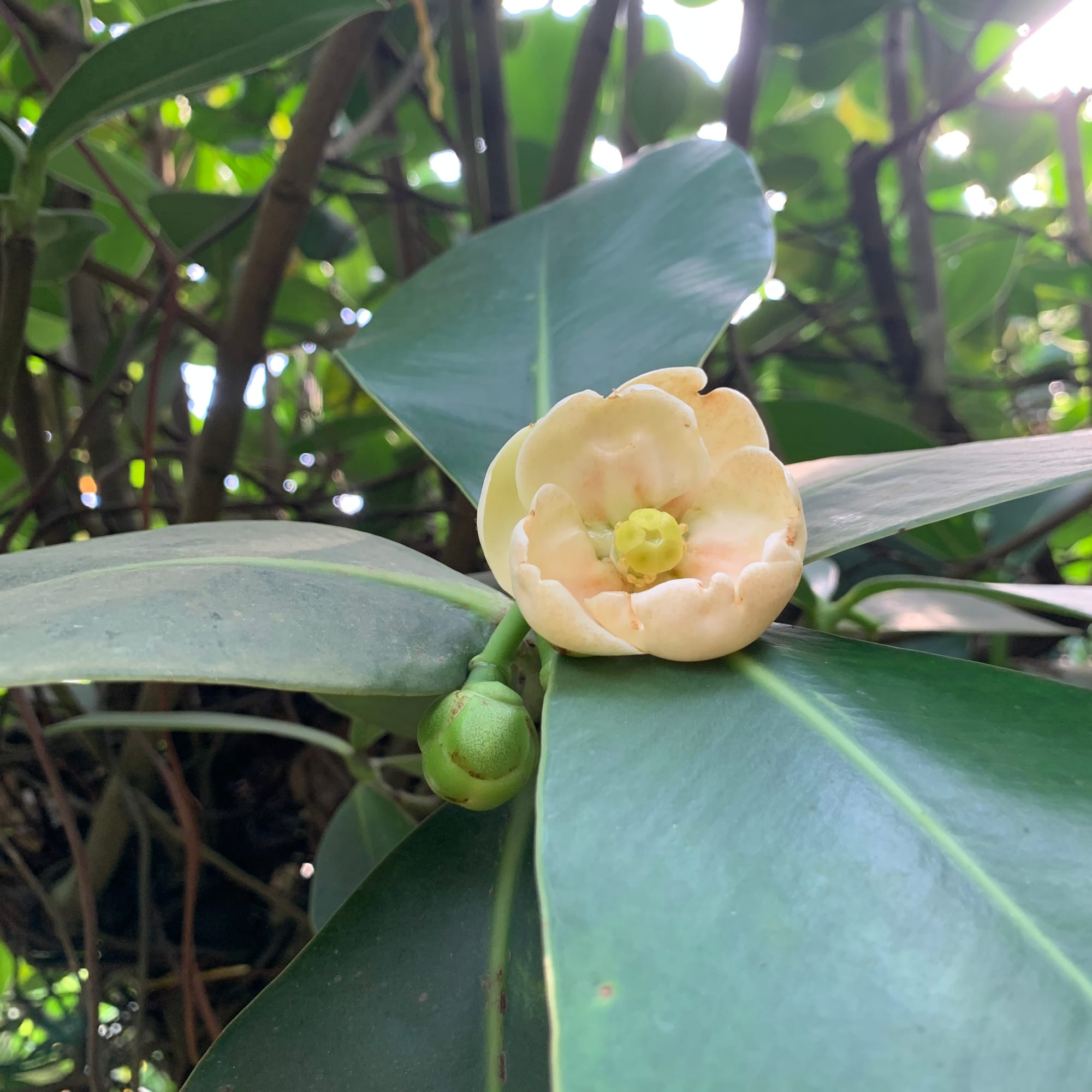 The flower of an Autograph Plant (Clusia rosea)
The flower of an Autograph Plant (Clusia rosea)
Repotting
Repot every two years in the spring, using a 'Houseplant' labelled potting mix and the next sized pot with adequate drainage. Autograph Trees are far better potbound for several years due to the heightened risk of root rot and repotting-issues (like transplant shock) - so only repot if you feel it's wholly necessary.
Hydrate the plant 24hrs before tinkering with the roots to prevent the risk of transplant shock. For those situated in a darker location, introduce extra amounts of perlite and grit into the lower portion of the new soil to downplay over-watering risks. Click here for a detailed step-by-step guide on transplantation, or via this link to learn about repotting with root rot.
Book a 1-to-1 video call with THE HOUSEPLANT DOCTOR™ if you'd like a personal guide to repotting your houseplant. This will include recommending the right branded-compost and pot size, followed by a live video call whilst you transplant the specimen for step-by-step guidance and answer any further questions!
Pests & Diseases
Keep an eye out for mealybugs, aphids, spider mites, thrips & whitefly. Common diseases associated with this species are root rot, red leaf-spot, heart rot, botrytis & southern blight - click here to learn more about these issues.
Toxicity
This plant is classified as poisonous; if parts of the plants are eaten, vomiting, nausea and a loss of appetite could occur. Consumption of large quantities must be dealt with quickly; acquire medical assistance for further information.
Retail Locations
IKEA & Online Stores.
Book a 1-to-1 Call with THE HOUSEPLANT DOCTOR™
If you need further advice with your houseplants, book an advice call with ukhouseplants' friendly and expert writer today! This can be done via a video or audio call on most apps, including Facebook, FaceTime & Skype. A ten-minute call costs £6.95 (US$8), or £15.95 for thirty minutes. You can ask multiple questions, including queries on plants, pests, terrariums, repotting advice and anything in between. Please consider supporting this service to keep ukhouseplants thriving!